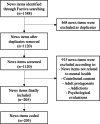Spanish media coverage of youth mental health issues during the COVID-19 pandemic
- PMID: 37563600
- PMCID: PMC10413772
- DOI: 10.1186/s12888-023-05054-7
Spanish media coverage of youth mental health issues during the COVID-19 pandemic
Abstract
Background: The media portrayal of mental health is relevant in shaping the population's attitudes towards mental disorders. However, there is little information about the representation of young mental health issues in the Spanish-language press, especially in the context of the COVID-19 pandemic. The general objective of this study was to analyse the tone and content of Spanish newspaper articles about mental disorders in youth during the COVID-19 pandemic.
Methods: We collected media articles from the 10 most read news sources over a 6 month period (January-June 2021). These articles were coded for content using a standardised codebook, followed by an inductive thematic analysis. A total of 205 news items were evaluated.
Results: Results showed that the majority of the news items had an overall positive tone (68.3%), only 5.4% were stigmatising and only 7.3% were related to violence. However, few articles offered help seeking information (6%), adolescents were rarely quoted (14%) and children were never quoted. Substantial differences are described in terms of age, gender and disorder. The thematic analysis led to three emergent themes: (i) violence and victimisation; (ii) the COVID-19 pandemic; and (iii) technology and social media.
Conclusions: The percentage of news in the Spanish media that refer to young people's mental health in a stigmatising way or in a way associated with violence is very low. Furthermore, the COVID-19 pandemic may have promoted more positive discussion about youth mental health. However, major challenges remain to be addressed, as patients are seldom quoted, very few articles offer help-seeking information, and a narrative of victimisation without appropriate discussion of resilience regularly occurs.
Keywords: Child; Mass media; Mental disorder; Mental health; Stigma; Youth.
© 2023. BioMed Central Ltd., part of Springer Nature.
Conflict of interest statement
The authors declare no competing interests.
Figures





Similar articles
-
Mental disorders in the media: A retrospective study of newspaper coverage in the Chilean Press.Int J Soc Psychiatry. 2022 Nov;68(7):1351-1362. doi: 10.1177/00207640211023086. Epub 2021 Jul 13. Int J Soc Psychiatry. 2022. PMID: 34254543
-
Canadian news media coverage of suicide during the COVID-19 pandemic.Soc Psychiatry Psychiatr Epidemiol. 2023 Jul;58(7):1087-1098. doi: 10.1007/s00127-023-02430-2. Epub 2023 Jan 25. Soc Psychiatry Psychiatr Epidemiol. 2023. PMID: 36695916 Free PMC article.
-
Suicide portrayal in the Canadian media: examining newspaper coverage of the popular Netflix series '13 Reasons Why'.BMC Public Health. 2018 Aug 31;18(1):1086. doi: 10.1186/s12889-018-5987-3. BMC Public Health. 2018. PMID: 30170588 Free PMC article.
-
The Changing Job of School Nurses during the COVID-19 Pandemic: A Media Content Analysis of Contributions to Stress.Ann Work Expo Health. 2023 Jan 12;67(1):101-117. doi: 10.1093/annweh/wxac053. Ann Work Expo Health. 2023. PMID: 36111528 Free PMC article. Review.
-
Impact of COVID-19 and lockdown on mental health of children and adolescents: A narrative review with recommendations.Psychiatry Res. 2020 Nov;293:113429. doi: 10.1016/j.psychres.2020.113429. Epub 2020 Aug 24. Psychiatry Res. 2020. PMID: 32882598 Free PMC article. Review.
References
-
- Goffman E. Stigma: notes on the management of spoiled identity. Englewood Cliffs, N.J: Prentice-Hall; 1963.
-
- Link BG, Phelan JC. Conceptualizing Stigma. Annu Rev Sociol. 2001;27:363–85. doi: 10.1146/annurev.soc.27.1.363. - DOI
-
- Link B Implications of outpatient commitment and perceived coercion for stigma, quality of life and social functioning. BMC Psychiatry 7 (Suppl 1), S124, Powell PW, Michaels KJ. PJ. The effects of news stories on the stigma of mental illness. J Nerv Ment Dis 2013;3:179–182. 10.1097/NMD.0b013e3182848c24. - PubMed
-
- Lahera G, Gálvez JL, Sánchez P et al. Functional recovery in patients with schizophrenia: recommendations from a panel of experts. BMC Psychiatry. 2018;18(1):176. Published 2018 Jun 5. doi:10.1186/s12888-018-1755-2DuPont-Reyes MJ. Leveraging Latinx and Spanish-Language Media to Achieve Mental Health Equity. Psychiatr Serv 2021;73(7):823–826. 10.1176/appi.ps.202100147.
-
- Shohel TA, Nasrin N, Farjana F, Shovo TE, Asha AR, Heme MA, Islam A, Paul P, Hossain MT. He was a brilliant student but became mad like his grandfather’: an exploratory investigation on the social perception and stigma against individuals living with mental health problems in Bangladesh. BMC Psychiatry. 2022;22(1):702. doi: 10.1186/s12888-022-04359-3. - DOI - PMC - PubMed
Publication types
MeSH terms
LinkOut - more resources
Full Text Sources
Medical

